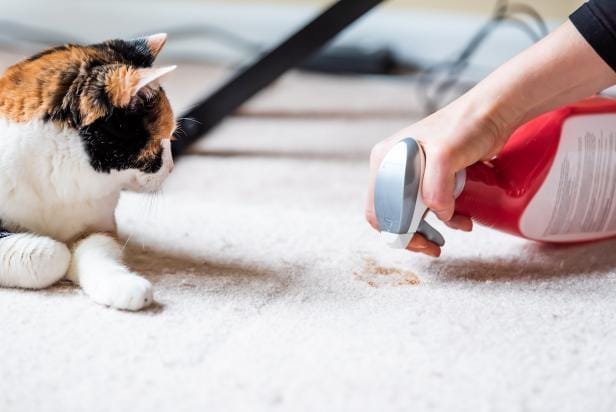As a cat guardian, you’re likely well-acquainted with the immense joy these furry companions add to our lives. Yet, the challenge arises when your cat accidentally urinates on the carpet, leaving behind a displeasing stain and a potent odor that stubbornly adheres to the carpet fibers.
You might have tried using a Bissell or other commercial carpet cleaners, only to discover the persistent odor remains. Fear not, for there are still several home remedies and strategies you can employ to eradicate the offensive smell and restore your home’s freshness.
Understanding Cat Urine Odors
Grasping why cat urine odor is so stubborn is key before tackling its removal. Cat urine contains high levels of ammonia, a metabolic byproduct. When cat urine is left untreated, bacteria break down the urea, emitting an ammonia-like smell reminiscent of old, stale urine. Eventually, these bacteria produce mercaptans, the same compounds that give skunk spray its notorious, lingering scent.
To effectively eliminate cat urine odor, superficial cleaning isn’t enough; you must target the odor at its source. Below are strategies to help you achieve this:
1. Locate all affected spots.
First, identify every urine-stained area, which might be invisible at first glance. Use a blacklight in a darkened room to find all urine traces and mark them with chalk or a sticky note.
2. Blot up as much urine as possible.
For fresh stains, absorb as much urine as you can with an absorbent cloth or paper towel. Avoid scrubbing the stain to prevent pushing the urine deeper into the carpet.
3. Try a vinegar solution.
Create a mixture of equal parts water and white vinegar and apply it to the stain. Vinegar’s acidity helps neutralize the ammonia in cat urine. Let it sit for a few minutes before blotting it dry with a clean towel.
4. Opt for an enzymatic cleaner.
These cleaners are designed to break down urine proteins, aiding in odor and stain removal. Follow the product’s instructions for application and let it sit as directed before blotting.
5. Make your own solution.
Combine 10 ounces of 3% hydrogen peroxide, 3 tablespoons of baking soda, and a few drops of dish soap in a spray bottle. Test for colorfastness before applying to the affected area. Let it dry, then vacuum thoroughly.
6. Steer clear of heat.
Heat can permanently set the stain and odor, making removal harder. Use cool or lukewarm water for cleaning urine stains.
7. Prevent future incidents.
After addressing the odor, figure out why your cat avoided their litter box and take steps to prevent future accidents. This could be due to health issues, stress, or an unclean litter box. Consult a veterinarian and ensure the litter box is regularly cleaned and placed in a calm, accessible area.
In summary, while commercial cleaners like Bissell may work for various stains and odors, they’re not always successful against cat urine smells. It’s a vexing problem, but with the correct approach and solutions, you can remove the odor and avert future accidents. If the smell persists despite your best efforts, the urine may have seeped through to the carpet pad or subfloor, requiring professional help or replacement of the affected carpet and padding.

